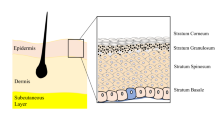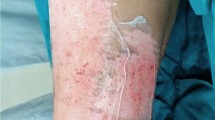Summary
Many articles have been written about wound contraction. The majority of these use animals as these experiments are impossible to repeat in humans for ethical reasons. Skin graft donor sites have been used in this study as repeatable controlled wounds. Wound contraction does occur in these wounds and it can be reduced by covering the wound with a synthetic dressing.
Similar content being viewed by others
References
Corps BVM (1969) The effect of graft thickness, donor site and graft bed on graft shrinkage in the hooded rat. Br J Plast Surg 22:125
Eaglstein WH (1984) The effect of occlusive dressings on wound healing. In: Eaglstein WH (ed) Wound healing. Lippincott, Philadelphia, pp 107–111
Eisenger M, Sadan S, Silver LA, Flick RB (1988) Growth regulation of skin cells by epidermal cell derived factors: implications for wound healing. Proc Natl Acad Sci USA 85:1937–1941
Frank DH, Brahme J, Van de Berg JS (1984) Decrease in rate of wound contraction with the temporary skin substitute biobrane. Ann Plast Surg 12:519–524
Frank DH, Bonaldi LC (1985) Inhibition of wound contraction: comparison of full-thickness skin grafts, biobrane, and aspartate membranes. Ann Plast Surg 14:103–110
Foresman PA, Tedeschi KR, Rodeheaver GT (1986) Influence of membrane dressings on wound contraction. J Burn Care Rehabil 7:398–403
Grabb WC, Smith JW (1979) Plastic surgery, 3rd edn. Little, Brown and Company, Boston, p 17
Gore SM, Altman DG (1989) Statistics in practice. Br Med Assoc, London, pp 38–54
James MI (1990) Reduction of contraction of split skin grafts with a synthetic dressing. Eur J Plast Surg 13:97–100
Lynch SE, Nixon JH, Colvin RB, Antoniades HN (1987) Role of platelet derived growth factor in wound healing: synergistic effects with other growth factors. Proc Natl Acad Sci USA 84:7696–7700
Padgett EC (1942) Skin grafting. Springfield, 111, pp 34–68
Phillips LG, Robson MC, Smith DJ, Phillips WA, Gracia WD, McHugh TP, Sullivan WG, Mathoney K, Swartz K, Meltzer T (1989) Uses and abuses of a biosynthetic dressing for partial thickness skin burns. Burns 15:254–256
Rudolph R, Klein L (1973) Healing processes in skin grafts. Surg Gynecol Obstet 136:641–653
Rudolph R (1979) Inhibition of myofibroblasts by skin grafts. Plast Reconstr Surg 63:473–480
Sawhney CP (1977) The influence of skin tension on the contraction of open wounds and skin grafts in rabbits. Br J Plast Surg 30:115–117
Author information
Authors and Affiliations
Rights and permissions
About this article
Cite this article
James, M.I., Stevenson, J.H. Reduction of open wound contraction in humans with a synthetic dressing. Eur J Plast Surg 13, 189–191 (1990). https://doi.org/10.1007/BF00634565
Issue Date:
DOI: https://doi.org/10.1007/BF00634565




